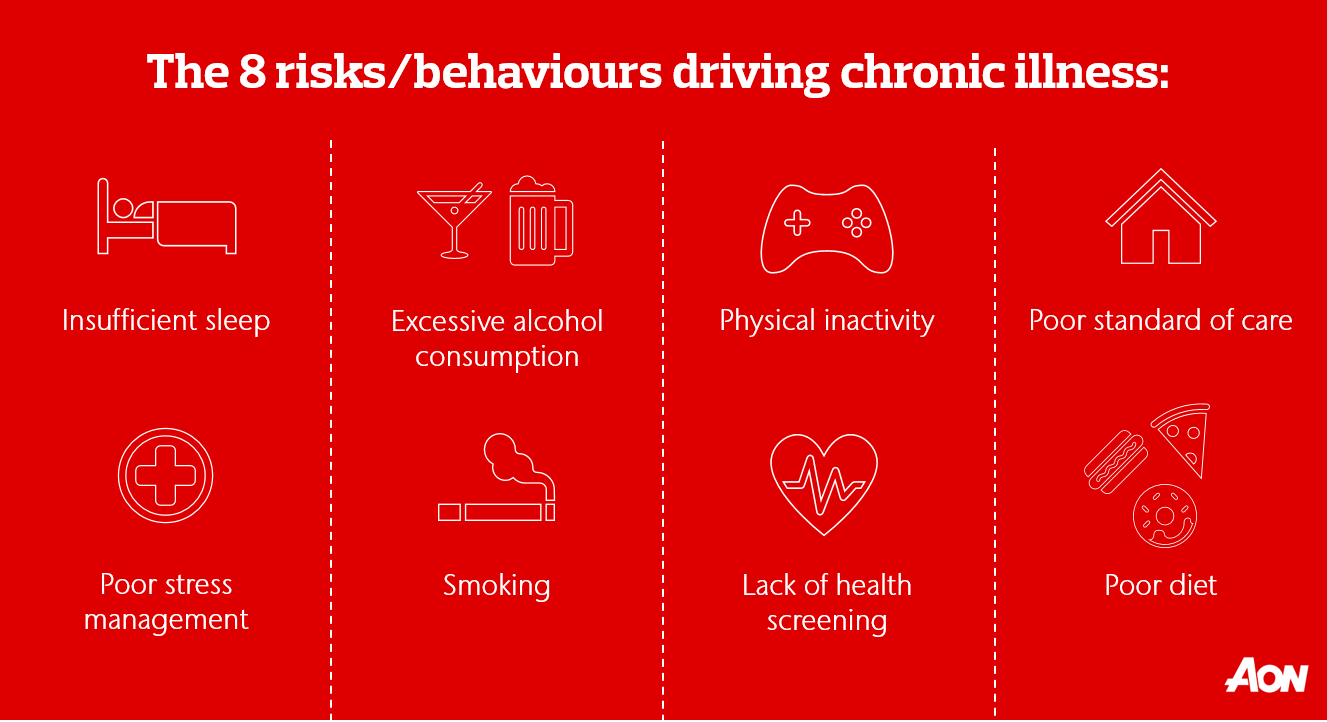August 2019
By Richard Morgan
In our previous article, we looked at the challenges facing employers in achieving sustainable behaviour change in terms of staff engagement, achieving board buy-in and workforce planning.

According to the World Health Organisation’s Tackling Chronic Disease 2010 report, 80 per cent of the total cost of chronic illness worldwide can be attributed to 15 chronic health conditions. These health conditions are driven by just eight risks and behaviours:

In the first article in the series, we talked about the move towards prevention and education rather than treatment and this is precisely why: prevention is always better than cure. So while we’d urge caution with generalising health conditions and their possible causes, the WHO’s 2010 findings can be a good starting point for employers setting out on their health and wellbeing journey.
So with all this in mind, how can employers bring about sustainable behaviour change through health and wellbeing schemes? The answer of course, is many-fold, not least because the one-size-fits-all approach absolutely does not fit all.
Uncover the why before the what
Too often, businesses treat health and wellbeing as a tick-box exercise. They might send out one-off communications on mental health then assume it’s job done. But effective health and wellbeing initiatives need to be long-term. It’s a process, not an event.
Instead, take a consultancy approach. Why are you doing this? Why is it important to your business and your people? Employers need to ascertain the why before they can work out the issues at stake. Is it to improve employee engagement and productivity levels? To reduce accident rates? Because it’s the right thing to do? Identifying your why will give you a clear benchmark to measure effectiveness and ultimate success.
Do your research
Just as businesses need to understand their customer and their motivations, needs and preferences, employers need to take the same approach with their employees. So do the research and understand as much as you can about your employee. We’re lucky that we have a wealth of data at our fingertips. Data can give us demographic profiles, salary, information about personal circumstances, whether an employee owns their own home or rents, how near they are to retirement, if they have any health conditions listed.
Data can tell you if mental health is a big issue among your workforce, or if there’s an issue with musculoskeletal disorders. There might be productivity issues, or large numbers of errors and accidents happening within the workplace. Once you have a clear idea of the issues and of course potential health issues affecting your workforce, you’ll have clear idea of which areas to target.
Market your communications
Just as employers need to start thinking about their staff as customers, it makes sense to think about communications from a marketing perspective. Employers need to market their health and wellbeing communications in such a way that staff will sit up and take notice. Keep it simple:
- Focus on eight key issues throughout the year which are going to have the biggest impact on peoples’ wellbeing
- Pick one issue at a time and work-out a long-term communications plan for that issue. You don’t want to bombard your staff with lots of different information or they’ll switch off, so focus on stress one month, then maybe sleep the next.
- Tie the campaign with national campaigns along the way
- Include a ‘call to action’ in every campaign and make it easy for employees to act on it.
In essence, effective communication campaigns are about nudging rather than spoon-feeding, so it’s important not to give too much information - just enough to intrigue and motivate. Video can be a good way of getting messages across: you can convey important messages in a 45-60 second video which can be viewed on a smartphone or tablet during the daily commute.
Avoid, need, support
Ultimately, we’d advise employers to focus on three areas within their health and wellbeing strategies to encourage sustainable behaviour change:
- Avoid – What do employees need to avoid to stay healthy? Use initiatives and suggestions to help prevent illness and unhealthy lifestyle choices (free fruit, health screening, quit smoking campaigns)
- Need – Use initiatives and programmes to help support employees on the road to recovery once a health issue has been identified or diagnosed (EAPs, occupational health, counselling etc)
- Support – Provide long-term support programmes to support employees with chronic illness (PMI, life assurance etc)
In line with current thinking, the emphasis should always be on ‘avoid’, to help encourage healthy lifestyle choices. This will also help to control costs in the need and support phases.
Review and improve, constantly
No health and wellbeing strategy is ever truly complete. It needs to evolve over time, reflect employees’ changing needs and react to political, economic and social trends. Right now, rising living costs is a big issue for many employees, hence the growing financial wellbeing trend. Indeed, 62.5 per cent of managerial respondents to the Aon Benefits and Trends Survey 2019 said employee financial wellbeing is the responsibility of the employer.
Ultimately though, employers will want to know if they have indeed achieved sustainable behaviour change among their workforce, but this will look different for every business. Yes, there may be key indicators such as a sustained reduction in sickness absence, increased productivity levels or a significant reduction in workplace accidents, but to really know, employers must go back to their unique benchmark, their why-are-we-doing-this? exercise.
So if the answer to the question, ‘are we achieving what we set out to do?’ is yes (albeit with more specifics and data-rich insight) pat yourself on the back and keep up the good work. But if the answer is no, you may have your work cut out for you. The question is, are you up to the challenge?

For more information or to discuss any of the issues outlined in this article, please get in touch by emailing us at [email protected] or call us on 0344 573 0033.
Aon UK Limited is authorised and regulated by the Financial Conduct Authority. Registered in England and Wales. Registered number: 00210725. Registered Office: The Aon Centre, The Leadenhall Building, 122 Leadenhall Street, London EC3V 4AN.